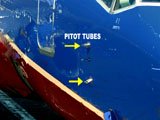Pitot-Static System
One of the basic flight systems on your aircraft is the pitot-static system. This system, on all aircraft from the Cessna 172 to the Airbus 380, uses air pressure differences to measure speed and altitude. The three basic instruments that all aircraft have and that use these pressure differences are the airspeed indicator, Vertical Speed Indicator (VSI), and the altimeter.. Pitot pressure, also called ram pressure, is connected only to the airspeed indicator. The static, or ambient pressure is connected to all three. In addition, on almost all airline aircraft, the this system also supplies input to the Air Data Computers (ADCs), Air Data Inertial Reference System (ADIRS), and other systems such as the cabin pressurization system and the Ground Proximity Warning System (GPWS).
The pitot-static system is comprised of pitot tubes and static ports that are usually located on either side of the forward fuselage, underneath the pilots’ windows. In addition, some aircraft can have pitot tubes on either side of the elevator (tail area). The pitot tubes are mounted parallel to the longitudinal axis of the aircraft and generally in line with the relative wind. There are always several pitot tubes and static ports so that the pressure readings can be averaged out and also to ensure that there are backup and alternate sources. Depending on the aircraft you are flying on, most pitot tubes are electrically heated to keep the pitot system clear when flying through moisture. Some static ports are as well.

|
| Pitot Tubes |
When the pilots and/or maintenance personnel are doing the “walk-around” (to be described later), one of the many things they are checking is that these tubes and ports are clear of any obstructions. There have been several cases in the past, from general aviation aircraft to airline aircraft, that these were not checked properly. For instance, there have been wasp nests in pitot tubes. When aircraft have been painted or washed, the static ports are taped over to prevent anything from getting in. After the aircraft is done, sometimes the tape was not removed and not caught later on, which has led to accidents. As you can see, something so basic provides valuable pressure differential information to many systems throughout the aircraft.

|
| Pitot-Static System Schematic Example |
One of the theories concerning the Air France Flight 447 crash on June 1, 2009; is that the pitot tubes might have been contaminated, iced over, or not working properly.
This could have possibly lead to erroneous airspeed readings and/or provide misleading information to other systems.
Pitot-Static System back to My Airline Flight